Nepal Bhasa movement
Nepal Bhasa movement (Newar: नेपालभाषा आन्दोलन) refers to the struggle for linguistic rights by Newar speakers in Nepal in the face of opposition from the government and hostile neighbors. The campaign aims to increase the use of Nepal Bhasa in the home, education, government and business. Despite a high level of development, Newar culture and language are both under threat.[1]
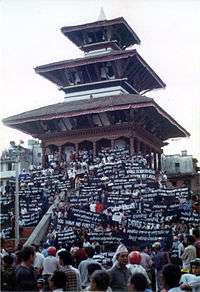
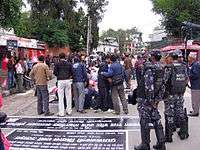
Newars have been fighting to save their language from the time of the repressive Rana regime till today, and activists have been jailed, exiled and tortured.[2][3] Opponents have even petitioned the Supreme Court to have its use barred. The history of Nepal Bhasa since the late 18th century has been marked by constant struggle against state repression and a hostile environment.[4][5]
The movement arose against the suppression of the language by the state that began with the rise of the Shah dynasty in 1768 AD, and intensified during the Rana regime (1846-1951) and Panchayat system (1960-1990).[6][7] Moreover, hostility towards the language from neighbors grew following mass migration into the Kathmandu Valley, leading to the indigenous Newars becoming a minority in their homeland. During the period 1952 to 1991, the percentage of the valley population speaking Nepal Bhasa dropped from 74.95% to 43.93%.[8] The language has been listed as being "definitely endangered" by UNESCO.[9]
The language movement can be divided into the following eras.
- Shah/Rana era
- First democratic era
- Panchayat era
- Second democratic era
- Loktantra era
Shah/Rana era
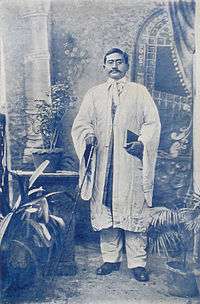
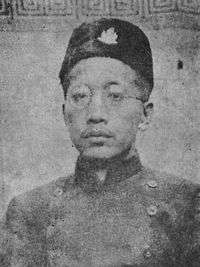
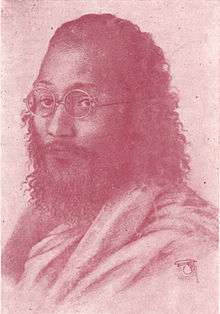
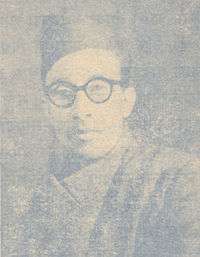
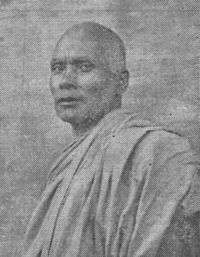
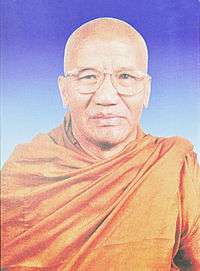
Following the advent of the Shahs, the Gorkha language became the court language of Nepal,[10] and Nepal Bhasa was replaced as the language of administration.[11] Open suppression began in 1906 with documents in Nepal Bhasa being declared not admissible in court. In the subsequent years, authors were fined, whipped, imprisoned or expelled and their books confiscated.[12][13] It was illegal to sing hymns in Nepal Bhasa[14] or speak it on the telephone.[15] As a result, development of the language and literature was stifled.
During the period 1909 to 1941 known as the Renaissance era, a few authors braved official disapproval and started writing, translating, educating and restructuring the language. Writers Nisthananda Bajracharya, Siddhidas Mahaju, Jagat Sundar Malla and Yogbir Singh Kansakar are honored as the Four Pillars of Nepal Bhasa. Shukraraj Shastri and Dharmaditya Dharmacharya were also at the forefront of the movement.
In 1909, Bajracharya published the first printed book using movable type. Shastri wrote a grammar of the language entitled Nepal Bhasa Vyakarana which was published from Kolkata, India in 1928.[16] Dharmacharya published the first magazine in Nepal Bhasa Buddha Dharma wa Nepal Bhasa from Kolkata in 1925. Also, the Renaissance marked the beginning of the movement to get official recognition for the name "Nepal Bhasa" in place of the Khas imposed term "Newari".
Writers jailed
In 1940, the government mounted a crackdown against democracy activists and writers in which Shukraraj Shastri was hanged. A large number of authors were imprisoned for their literary or political activities. Dharmacharya was jailed for three months. Chittadhar Hridaya was sentenced to six years, Siddhicharan Shrestha was sentenced to 18 years, Phatte Bahadur Singh was sentenced to life imprisonment and Dharma Ratna Yami was sentenced to 18 years.[17] They were released in 1945 after serving five years. In prison, Hridaya produced his greatest work Sugata Saurabha,[18] an epic poem on the life of the Buddha.[13] Shrestha wrote a collection of poems entitled Seeswan ("Wax Flower", published in 1948) among other works.
Monks expelled
Theravada Buddhist monks stood up to the Rana regime and published books on Buddhism from India and brought them into Nepal. This led to the Banishment of Buddhist monks from Nepal. In 1944, eight monks were expelled for refusing to stop teaching Theravada Buddhism and writing in Nepal Bhasa. In 1946, the ban on writing was lifted, and the monks were allowed to return to Nepal following international pressure.[19] Their writings and public activities in Nepal Bhasa had a profound impact on the development of the language.[20][21]
Working abroad
Nepal Bhasa lovers took the movement to India and Tibet where they formed associations to organize writers and bring out publications to escape government suppression in Nepal. Newar merchants based in Kolkata, Kalimpong and Lhasa were major patrons of the language movement.
Buddha Dharma wa Nepal Bhasa, the first ever magazine in Nepal Bhasa, was published from Kolkata in 1925 by Dharmaditya Dharmacharya. He also established a literary organization named Nepal Bhasa Sahitya Mandal (Nepal Bhasa Literature Organization) in 1926.[22][23]
In 1944, the Buddhist monks expelled from Nepal went to Sarnath and formed an organization named Dharmodaya Sabha. In 1947, it launched Dharmodaya magazine from Kalimpong funded by trader Maniharsha Jyoti Kansakar. Monk Aniruddha Mahathera was the first editor.[24][25]
Newar traders based in Lhasa promoted Thaunkanhe magazine which launched in Kathmandu in 1951. It was the first Nepal Bhasa magazine to be published from Nepal, and the first editor was a former merchant Purna Kaji Tamrakar.
In 1950, a literary society named Chwasa Pasa (Pen Friend) was formed in Kolkata by Prem Bahadur Kansakar and another writer Madan Lochan Singh to bring together writers living in exile. The society moved to Nepal in 1951 after the advent of democracy.[26]
First democratic era
Following the fall of the Ranas and advent of democracy in 1951, there was greater linguistic freedom, and Nepal Bhasa struggled to catch up. Books, magazines and newspapers appeared. A daily newspaper Nepal Bhasa Patrika began publication in 1955.[27]
On the radio
State-owned Radio Nepal began broadcasting the news in Nepal Bhasa once a day in 1951. In 1958, Kathmandu Municipality passed a resolution that it would accept applications and publish major decisions in Nepal Bhasa in addition to the Nepali language.[28]
In schools and colleges
Nepal Bhasa entered a vibrant phase in the educational system. It was included in the curriculum, and Nepal Rastriya Vidhyapitha recognized it as an alternative medium of instruction in the schools and colleges affiliated to it. In 1953, the government recognized Nepal Bhasa as a spoken language and an oriental language subject. The Nepal Educational Council adopted it as an optional subject.
Following lobbying by language lovers, Nepal Bhasa was included in the course of study at the high school level in 1954, at the intermediate level in 1960 and bachelor level in 1962. And for two decades, Nepal Bhasa was widely taught in schools and colleges in the Kathmandu Valley and other parts of Nepal with thousands of students studying it as an optional subject.[2]
Panchayat era
In 1960, parliament was abolished, political parties were forbidden and the Panchayat system was established. Under this autocratic system, the government followed a one-language policy, and Nepal Bhasa suffered another period of suppression.[29][30] It was gradually pushed out of the media and the educational institutions, triggering protest movements.[31]
The restrictive policy of Panchayat encouraged the formation of literary associations to provide a forum for writers to present their works. In 1962, Birat Nepal Bhasa Sahitya Sammelan Guthi (Grand Nepal Bhasa Literary Conference Trust) was formed in Bhaktapur. It organized annual literary meets which continue till today.[32]
Jah magazine
In 1960, Nepal Bhasa students at Tri-Chandra College in Kathmandu launched an annual magazine named Jah (ज:) (meaning "light" in Nepal Bhasa) after the college magazine Light refused to include Nepal Bhasa articles in it. The magazine led to the organization of students interested in Nepal Bhasa in the college. That same year, they started the annual Inter-College Nepal Bhasa Literary Conference and also produced a weekly radio program in Nepal Bhasa on Radio Nepal named Jeevan Dabu ("Life's stage"). In the successive years, Jah served as a breeding ground for new writers and language activists.[33]
Movement of 1965
In 1963, Kathmandu Municipality's decision to recognize Nepal Bhasa was revoked. In 1965, the language was banned from being broadcast over Radio Nepal.[34][35] The removal of Nepal Bhasa from the country's only radio station sparked a protest movement which became known as the Movement of 1965 ("Bais Salya Andolan"). The protest took the form of literary meets as other types of demonstrations were prohibited. Literary programs were held weekly in market squares and courtyards where participants recited poems and sang songs containing critical messages.
The government cracked down by putting a number of activists in jail including writers Mangal Man Shakya, Pushpa Gopal Shrestha and Shree Krishna Anu.[36] Buddhist monk Bhikshu Sudarshan Mahasthavir was jailed for six months and six days.[37] Other prominent campaigners like Durga Lal Shrestha, Hitkar Bir Singh Kansakar and Mangal Man Shakya (of Om Bahal) were forced to go underground. The movement was made leaderless, and it came to a stop after a year.[38]
The ban on Nepal Bhasa remained, but the 1965 Movement succeeded in raising awareness about linguistic rights and arousing public opinion against the Panchayat regime. Its most important achievement was creating a new generation of writers and campaigners who would take over from the activists who fought for the language during the Rana regime and lead the movement in the subsequent decades.[31][39] Nepal Bhasa Manka Khala, founded in 1979, is one of the organizations that emerged during this period to struggle for language rights.
Out of school
The New Education System Plan brought out in 1971 disrupted the popular study of Nepal Bhasa in educational institutions.[40] Under the plan, vernacular subjects were removed from the curriculum, and students were forced to choose between the mother tongue and technical subjects, leading to Nepal Bhasa being pushed into the background.[41] Student enrolment in the course dropped, resulting in the subject being pulled out of many schools and a further decline in students.
From 1977, students could study Nepal Bhasa at the Master's level; but the university degree was not counted for promotion by the government, and so there were few takers for the subject.[42][43]
Foreign radio
In addition to government suppression, Nepal Bhasa has faced opposition from hostile critics. After Sri Lanka Broadcasting Corporation began broadcasting a weekly half-hour program in Nepal Bhasa on 6 November 1983, opponents in Nepal pressured the radio station to shut it down. Similar opposition led to All India Radio - Kurseong stopping broadcasting Nepal Bhasa songs during its Nepali service in 1966.[44][45]
Second democratic era
Arbitrary actions increased resentment towards Panchayat. In 1988, police arrested participants in a procession marking the birth anniversary of Nepal Bhasa poet Siddhidas Mahaju.[46]
After the 1990 People's Movement that brought the Panchayat system to an end, the languages of Nepal enjoyed greater freedom.[47] However, efforts to get Nepal Bhasa reincluded as an optional subject after a gap of two decades were unsuccessful due to lack of funding.
The 1990 constitution recognized Nepal as a multi-ethnic and multilingual country. It also said that each community shall have the right to operate schools up to the primary level in its own mother tongue.[48] However, the government's responsibility was not stated and communities had to open such schools on their own. In 1991, Jagat Sundar Bwane Kuthi, the first Nepal Bhasa-medium school, opened in Kathmandu with the efforts of volunteers and the support of domestic and foreign donors.[43]
Meanwhile, years of efforts to gain official recognition for the standard name Nepal Bhasa finally succeeded. On 8 September 1995, the government decided that the name Nepal Bhasa should be used instead of Newari.[49] However, the Central Bureau of Statistics has not been doing so.[50]
Critics file suit
On 25 July 1997, Kathmandu Metropolitan City declared that its policy to recognize Nepal Bhasa, which had been passed on 18 April 1958 and cancelled by the Panchayat regime in 1963, would be revived.[51] The rest of the city governments in the Kathmandu Valley announced in quick succession that they too would officially recognize Nepal Bhasa -- Lalitpur Sub-Metropolitan City on 14 July, Bhaktapur Municipality on 23 July, Madhyapur Thimi Municipality on 10 September, Banepa Municipality on 7 October, Dhulikhel Municipality on 10 October, and Kirtipur Municipality on 15 September 1997.
While Newars hailed the move, its detractors went to court. A group consisting of Lal Bahadur Thapa, Yagyanidhi Dahal, Hari Prasad Pokhrel, Achyut Raman Adhikari and Dhruba Raj Thebe filed a joint petition at the Supreme Court of Nepal against their decision. And on 18 March 1998, the Supreme Court issued a stay order preventing Kathmandu Metropolitan City from using Nepal Bhasa pending a final verdict.[52][53]
Subsequently, on 1 June 1999, the Supreme Court quashed the decision of the local bodies as being unconstitutional.[54][55] After the verdict was announced, demonstrators marched through Kathmandu in protest.[56]
Black Day
Newars have been observing June 1 as Black Day with protest meets and public demonstrations recalling the day when the Supreme Court barred Nepal Bhasa from being used in local bodies. On some occasions, the protests have been marked by vandalism and arrest of protestors by the police.[57]
Loktantra era
A second People's Movement in 2006 ousted the Shah dynasty and Nepal became a republic which gave the people greater linguistic freedom. The 2007 Interim Constitution stated that the use of one's mother tongue in a local body or office shall not be barred.[58] However, subtle discrimination persists. Organizations with names in Nepal Bhasa are not registered, and municipality officials refuse to accept applications written in the language.[59][60]
See also
- Nepal Bhasa
- Nepal Bhasa literature
- Nepal Bhasa journalism
- Nepal Bhasa renaissance
- Linguistic rights
References
- Grandin, Ingemar. "Between the market and Comrade Mao: Newar cultural activism and ethnic/political movements (Nepal)". Missing or empty
|url=(help) - Hoek, Bert van den & Shrestha, Balgopal (January 1995). "Education in the Mother Tongue: The Case of Nepal Bhasa (Newari)" (PDF). CNAS Journal. Retrieved 22 April 2012. Page 75.
- Sthavir, Dharmalok (1 December 1977). "A Journey to Great China". Regmi Research Series. Regmi Research. Retrieved 11 October 2012. Pages 35-36.
- Singh, Pranab Man (17 September 2011). "The language divide". The Kathmandu Post. Retrieved 25 June 2013.
- Manandhar, T (7 March 2014). "Voice Of The People". The Kathmandu Post. Archived from the original on 7 March 2014. Retrieved 7 March 2014.
- Singh, Phatte Bahadur (September 1979). "Nepali Biharya Aitihasik Pristabhumi ("Historical Background of Nepali Bihar")". Jaa. Kathmandu: Nepal Bhasa Sahitya Pala, Tri-Chandra Campus. Page 186.
- Shrestha, Bal Gopal (January 1999). "The Newars: The Indigenous Population of the Kathmandu Valley in the Modern State of Nepal" (PDF). CNAS Journal. Retrieved 20 April 2012.
- Malla, Kamal P. "The Occupation of the Kathmandu Valley and its Fallout". p. 3. Archived from the original (PDF) on 8 January 2016. Retrieved 16 August 2013.
- "UNESCO Atlas of the World's Languages in Danger". Retrieved 27 August 2013.
- Levy, Robert I. (1990) Mesocosm: Hinduism and the Organization of a Traditional Newar City in Nepal. Delhi: Motilal Banarsidass Publishers. ISBN 81-208-1038-4. Page 15.
- Los Angeles County Museum of Art and Pal, Pratapaditya (1985) Art of Nepal: A Catalogue of the Los Angeles County Museum of Art Collection. University of California Press. ISBN 9780520054073. Page 19.
- Watters, David E. (Spring 2009). "Newār (Nepāl Bhāsā) (review)". Anthropological Linguistics. University of Nebraska Press. Retrieved 22 April 2012. Pages 89-92.
- Lienhard, Siegfried (1992). Songs of Nepal: An Anthology of Nevar Folksongs and Hymns. New Delhi: Motilal Banarsidas. ISBN 81-208-0963-7. Page 4.
- Pradhan, Bhuwan Lal (1997). "Jnanamala Bhajan Khalah". Newah Vijnana. Oregon: International Nepal Bhasha Sevaa Samiti. Pages 1-5.
- Hridaya, Chittadhar (1982, third ed.) Jheegu Sahitya ("Our Literature"). Kathmandu: Nepal Bhasa Parisad. Page 8.
- Bajracharya, Phanindra Ratna (2003). Who's Who in Nepal Bhasha. Kathmandu: Nepal Bhasa Academy. Page 27.
- Shrestha, Siddhi Charan (1983). "97 Sal Parva". Inap Vol. 1, No. 3.
- "Sugata Saurabha: An Epic Poem from Nepal on the Life of the Buddha by Chittadhar Hridaya". Oxford Scholarship Online. Retrieved 24 January 2012.
- Whelpton, John (2005). A History of Nepal. Cambridge University Press. p. 182. ISBN 9780521804707. Retrieved 3 July 2013.
- LeVine, Sarah and Gellner, David N. (2005). Rebuilding Buddhism: The Theravada Movement in Twentieth-Century Nepal. Harvard University Press. ISBN 0674019083, 9780674019089. Pages 47-49.
- Tewari, Ramesh Chandra (1983). "Socio-Cultural Aspects of Theravada Buddhism in Nepal". The Journal of the International Association of Buddhist Studies. Retrieved 19 April 2012. Pages 89-90.
- LeVine, Sarah and Gellner, David N. (2005) Rebuilding Buddhism: The Theravada Movement in Twentieth-Century Nepal. Harvard University Press. ISBN 978-0-674-01908-9. Pages 27-28. Retrieved 2 February 2012.
- Shrestha, Bal Gopal (January 1999). "The Newars: The Indigenous Population of the Kathmandu Valley in the Modern State of Nepal" (PDF). CNAS Journal. Retrieved 22 May 2012. Page 89.
- LeVine, Sarah and Gellner, David N. (2005) Rebuilding Buddhism: The Theravada Movement in Twentieth-Century Nepal. Harvard University Press. ISBN 9780674019089. Pages 121-122. Retrieved 22 May 2012.
- Joshi, Bhuwan Lal and Rose, Leo E. (1966) Democratic innovations in Nepal: A case study of political acculturation. University of California Press. Page 244.
- Tuladhar, Prem Shanti (2000). Nepal Bhasa Sahityaya Itihas: The History of Nepalbhasa Literature. Kathmandu: Nepal Bhasa Academy. ISBN 99933-560-0-X. Page 129.
- "History of Nepali Journalism". Nepal Press Institute. 15 February 2010. Retrieved 25 April 2012.
- Sandhya Times. 1 July 1997. Missing or empty
|title=(help) - Whelpton, John (2005). A History of Nepal. Cambridge University Press. p. 183. ISBN 9780521804707. Retrieved 3 July 2013.
- Lawoti, Mahendra. "Contentious Politics in Democratizing Nepal". Retrieved 3 June 2012. Page 9.
- Shrestha, Bal Gopal (January 1999). "The Newars: The Indigenous Population of the Kathmandu Valley in the Modern State of Nepal" (PDF). CNAS Journal. Retrieved 22 April 2012. Page 91.
- "Nepal Bhasha literary meet concludes". The Rising Nepal. 12 October 2008. Retrieved 18 May 2012.
- Tuladhar, Prem Shanti (2000). Nepal Bhasa Sahityaya Itihas: History of Nepalbhasa Literature. Kathmandu: Nepal Bhasa Academy. ISBN 99933-56-00-X. Page 114.
- Timalsina, Ramji (Spring 2011). "Language and Political Discourse in Nepal" (PDF). CET Journal. Itahari: Itahari Research Centre, Circle of English Teachers (CET). Retrieved 28 February 2012. Page 14.
- Gurung, Kishor (Nov–Dec 1993). "What is Nepali Music?" (PDF). Himal. Kathmandu: 11. Retrieved 4 April 2014.
- Tumbahang, Govinda Bahadur (September 2009). "Process of Democratization and Linguistic (Human) Rights in Nepal". Tribhuvan University Journal. Archived from the original on 21 September 2013. Retrieved 3 October 2012. Page 8.
- Shrestha, Ishwari Maiya (2010). Bhikshu Sudarshan wa Waykah ya Kriti Dhalah. Kathmandu: Bhikshu Sudarshan Memorial Group. Page 12.
- Maharjan, Basanta (2008). "Linguistic Movement of 2022 BS: A Case Study of the Newars in Kathmandu Valley". Retrieved 25 April 2012. Pages 15-19.
- Tuladhar, Prem Shanti (2000). Nepal Bhasa Sahityaya Itihas: History of Nepalbhasa Literature. Kathmandu: Nepal Bhasa Academy. ISBN 99933-56-00-X. Page 118.
- Dilas, Dragana Borenovic (2018). "Education in Nepal". WENR. Retrieved 24 December 2019.
- Shrestha, Gopal (1995). "Education in the mother tongue: the case of NepalBhasa (NEWARI)". Contributions to Nepalese Studies. 22 (1): 73–86.
- Hangen, Susan (2007). "Creating a "New Nepal": The Ethnic Dimension" (PDF). Washington: East-West Center. Retrieved 19 February 2012.
- Hoek, Bert van den & Shrestha, Balgopal (January 1995). "Education in the Mother Tongue: The Case of Nepal Bhasa (Newari)" (PDF). CNAS Journal. Retrieved 22 April 2012. Page 75.
- "Dakalay Nhapan". Bhintuna-Pau. Kathmandu: Nepal Bhasa Manka Khala. 1993. Page 67.
- Inap. 22 February 1984. Missing or empty
|title=(help) Page 1. - Tumbahang, Govinda Bahadur (September 2009). "Process of Democratization and Linguistic (Human) Rights in Nepal". Tribhuvan University Journal. Archived from the original on 21 September 2013. Retrieved 3 October 2012. Page 9.
- Eagle, Sonia (1999). "The Language Situation in Nepal". Journal of Multilingual and Multicultural Development. Scribd. Retrieved 28 February 2012. Page 310.
- "Constitution of Nepal 1990". Nepal Democracy. 2001. Retrieved 19 February 2012.
- "It's Nepal Bhasa". The Rising Nepal. 9 September 1995.
- "Major highlights" (PDF). Central Bureau of Statistics. 2013. Archived from the original (PDF) on 17 July 2013. Retrieved 24 May 2013.
- Sandhya Times. 1 July 1997. Missing or empty
|title=(help) - "Use Nepali, directs SC". The Kathmandu Post. 19 March 1998.
- "Stay order to KMC to stop using Newari". The Rising Nepal. 20 March 1998.
- Tumbahang, Govinda Bahadur (September 2009). "Process of Democratization and Linguistic (Human) Rights in Nepal". Tribhuvan University Journal. Archived from the original on 21 September 2013. Retrieved 3 October 2012. Page 18.
- Limbu, Ramyata (21 June 1999). "Attempt to Limit Official Language to Nepali Resented". IPS. Retrieved 8 January 2012.
- "SC quashes decisions on local languages". The Kathmandu Post. 2 June 1999. Retrieved 14 July 2013.
- "Kathmandu's sons go on warpath". The Times of India. 1 June 2009. Retrieved 17 May 2012.
- "The Interim Constitution of Nepal, 2063 (2007)" (PDF). UNDP Nepal. January 2009. Archived from the original (PDF) on 19 February 2012. Retrieved 19 February 2012. Page 56.
- "State affairs". The Kathmandu Post. 7 July 2013. Retrieved 18 July 2013.
- Shrestha, GG (23 May 2014). "Alien in Own Home". The Kathmandu Post. Kathmandu. p. 7. Retrieved 23 May 2014.